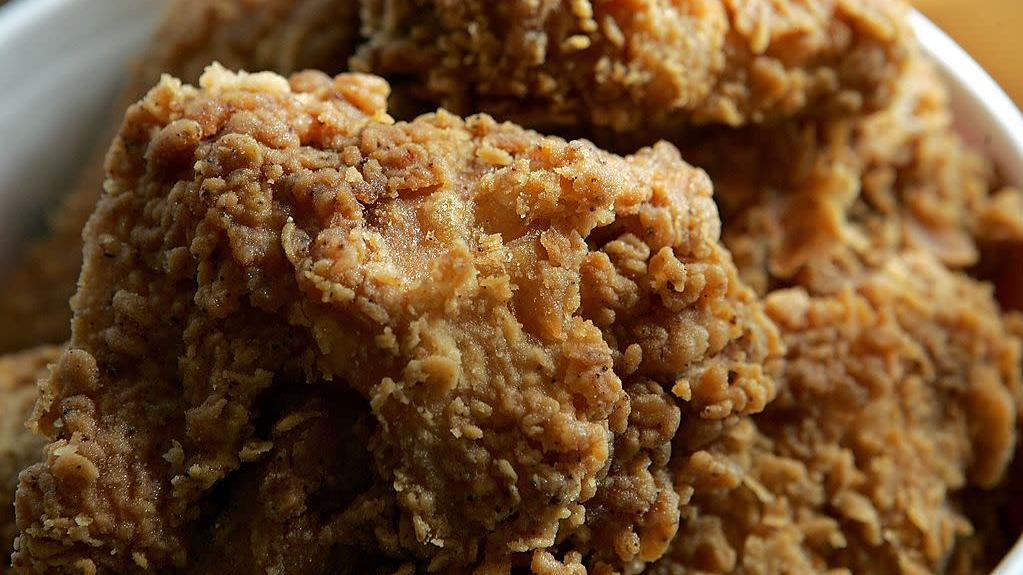How Do You Reheat Fried Chicken? (And Is It Even Worth It?)
Fried chicken is one of the best things in the whole wide world. Even at a fast-food joint, even if it's tofu or seitan instead of actual chicken, it's delicious, but when it's in its ideal form, fresh from a cast-iron skillet filled with a mixture of butter and lard or vegetable oil, flavored with smoked ham or bacon, it is divine.
Good fried chicken has a crispy crust and tender, juicy meat. It's not too greasy. The breading sticks to the chicken. It's very difficult to return to these conditions once the chicken has cooled. Should we even bother?
According to Edna Lewis, the patron saint of Southern cooking, the preparation of fried chicken is an art, requiring great care and patience. In Freetown, the small Virginia community where Lewis grew up, fried chicken was only eaten in late spring and early summer, when the young chickens, "hand-raised and specially fed," were at their most tender. Freetowners ate their fried chicken for breakfast, after their morning chores were done, with biscuits and gravy. There is no mention of leftovers in The Taste Of Country Cooking, Lewis' great cookbook/memoir of her childhood. Perhaps this was because there were none. Or maybe because it was so obvious what one should do with leftover fried chicken, Lewis felt no need to mention it. Maybe there were no leftovers of this magnificent fried chicken. Or maybe it was understood that it was just as good eaten cold.
Nowadays, we are far more decadent. We get our fried chicken in restaurants and supermarkets all year round, and we also order more food than we can possibly eat so we can take it home. (Sometimes we even cook it ourselves, but for most of us, this is a rare act, undertaken with the highest degree of trepidation.) Leftovers are a fact of life.
Cooks Illustrated, the Bible of scientific-minded cooks everywhere, suggests allowing leftover fried chicken to come to room temperature, then cooking it at 400 degrees Fahrenheit until the internal temperature is 120 degrees. Timing will vary based on the size and shape of the chicken pieces, but a good guideline is 8 to 12 minutes for legs and thighs and 14 to 18 minutes for breasts.
A. Spring Council, who now runs Mama Dip's Kitchen, the legendary Chapel Hill, North Carolina, restaurant established by her mother, Mildred, concurs. "Although cold fried chicken tastes good," she writes in an email, "reheating brings back the crispy crust."
If you must use the microwave, Southern Living recommends covering a plate of chicken with a paper towel and reheating at 30-second intervals, flipping frequently, until the chicken is warm enough—though this comes with the warning that that microwaving can be "tricky" and "at best, the texture will not be the same."
But Paul Fehribach, owner and chef of Big Jones in Chicago, disagrees with all of this, vehemently. Fehribach takes his fried chicken—based on Lewis' recipe—very seriously. When Big Jones first opened, he served it infrequently because it was so time-consuming to prepare correctly. Eventually he caved to public pressure and put it on the menu permanently, to the delight of the masses, including me. I have never had any leftovers.
This is what he told me: "Personally, I wouldn't try. But if I did, I would put a pie pan of water in the bottom of the oven and preheat to 250. Put chicken in the center rack and heat for 30 minutes." A better idea, he said, if, for some reason you didn't want to eat it cold, would be to pick the meat from the bones (breading and all) and make a chicken salad or tortilla soup (but with premade stock). And then he reiterated: "Low oven, pan of water. Def no microwave." Plus a skull emoji.
So there you have it. Reheating fried chicken is a delicate operation. Undertake it if you dare.
